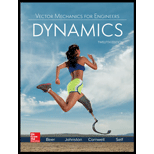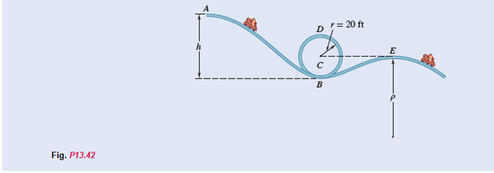
Concept explainers
A roller coaster starts from rest at A, rolls down the track to B, describes a circular loop of 40-ft diameter, and moves up and down past point E. Knowing that

(a)
Estimate the force exerted by the seat on the rider by using given information.
Answer to Problem 13.42P
The value of force at point B is NB=1120Ib and at point D is ND=160Ib.
Explanation of Solution
Given information:
Diameter=40ft
Height=60ft
The force exerted by the seat on the rider at point B and D.
Consider the free body diagram we get,
Mass of the rider is
Acceleration due to gravity is
Resultant acceleration acting on the rider at the point B is
Normal force exerted on the rider by the seat at the point B is
Resolve the forces acting on the rider by Newton’s second law.
Apply the principle of work and energy to the roller coaster at point A and point B.
Acceleration acting on the rider at the point B
Work done by the rider in reaching position B from position A is
The rider is at rest at position A is,
Then the kinetic energy of the rider at point B is,
Then the work done by the rider in reaching position B from position A,
Substitute above values we get,
Resultant acceleration acting on the rider at point B travelling in a circular track with radius of the curvature is r.
Substituting required values in the above equation we get,
Substitute
Now we get,
Forces acting on the riders by Newton’s second law
Apply the principle of work and energy to roller coaster at point A and point D. To determine the resultant acceleration acting on the rider at the point B is,
Work done by the rider in reaching position D from position A is
The rider is at rest at position A is,
Kinetic energy of the rider at point D is,
Work done by the rider in reaching position D from position A is
Substituting required values in equation 4 we get,
Express the resultant acceleration acting on the rider at point D travelling in a circular track with radius of curvature r.
Substitute h and r values we get,
Substitute required values we get,
Then,
(b)
The minimum value of radius of curvature by using given information.
Answer to Problem 13.42P
The value of radius of curvature at point E is=80ft determined below.
Explanation of Solution

Resolve the forces acting on the rider by Newton’s second law.
Roller coaster not to leave the tract at point E we get,
Apply the principle of work and energy to roller coaster at point A and point E.
Find the resultant acceleration acting on the coaster at the point E is,
The rider is at rest at position A.
Kinetic energy of the coaster at point E is,
Equating these two we get,
Substitute required values in above equation we get,
Resultant acceleration acting on the coaster at point E travelling in a circular track with radius of curvature is
Substitute above values we get,
Want to see more full solutions like this?
Chapter 13 Solutions
Vector Mechanics For Engineers
- 5. The figure shows a gear train. There is no friction at the bearings except for the gear tooth forces. The material of the milled gears is steel having a Brinell hardness of 170. The input shaft speed (n2) is 800 rpm. The face width and the contact angle for all gears are 1 in and 20° respectively. In this gear set, the endurance limit (Se) is 15 kpsi and nd (design factor) is 2. (a) Find the revolution speed of gear 5. (b) Determine whether each gear satisfies the design factor of 2.0 for bending fatigue. (c) Determine whether each gear satisfies the design factor of 2.0 for surface fatigue (contact stress). (d) According to the computation results of the questions (b) and (c), explain the possible failure mechanisms for each gear. N4=28 800rpm N₁=43 N5=34 N₂=14 P(diameteral pitch)=8 for all gears Coupled to 2.5hp motorarrow_forward1. The rotating steel shaft is simply supported by bearings at points of B and C, and is driven by a spur gear at D, which has a 6-in pitch diameter. The force F from the drive gear acts at a pressure angle of 20°. The shaft transmits a torque to point A of TA =3000 lbĘ in. The shaft is machined from steel with Sy=60kpsi and Sut=80 kpsi. (1) Draw a shear force diagram and a bending moment diagram by F. According to your analysis, where is the point of interest to evaluate the safety factor among A, B, C, and D? Describe the reason. (Hint: To find F, the torque Tд is generated by the tangential force of F (i.e. Ftangential-Fcos20°) When n=2.5, K=1.8, and K₁ =1.3, determine the diameter of the shaft based on (2) static analysis using DE theory (note that fatigue stress concentration factors need to be used for this question because the loading condition is fatigue) and (3) a fatigue analysis using modified Goodman. Note) A standard diameter is not required for the questions. 10 in Darrow_forward3 N2=28 P(diametral pitch)=8 for all gears Coupled to 25 hp motor N3=34 Full depth spur gears with pressure angle=20° N₂=2000 rpm (1) Compute the circular pitch, the center-to-center distance, and base circle radii. (2) Draw the free body diagram of gear 3 and show all the forces and the torque. (3) In mounting gears, the center-to-center distance was reduced by 0.1 inch. Calculate the new values of center-to-center distance, pressure angle, base circle radii, and pitch circle diameters. (4)What is the new tangential and radial forces for gear 3? (5) Under the new center to center distance, is the contact ratio (mc) increasing or decreasing?arrow_forward
- 2. A flat belt drive consists of two 4-ft diameter cast-iron pulleys spaced 16 ft apart. A power of 60 hp is transmitted by a pulley whose speed is 380 rev/min. Use a service factor (Ks) pf 1.1 and a design factor 1.0. The width of the polyamide A-3 belt is 6 in. Use CD=1. Answer the following questions. (1) What is the total length of the belt according to the given geometry? (2) Find the centrifugal force (Fc) applied to the belt. (3) What is the transmitted torque through the pulley system given 60hp? (4) Using the allowable tension, find the force (F₁) on the tight side. What is the tension at the loose side (F2) and the initial tension (F.)? (5) Using the forces, estimate the developed friction coefficient (f) (6) Based on the forces and the given rotational speed, rate the pulley set. In other words, what is the horse power that can be transmitted by the pulley system? (7) To reduce the applied tension on the tight side, the friction coefficient is increased to 0.75. Find out the…arrow_forwardThe tooth numbers for the gear train illustrated are N₂ = 24, N3 = 18, №4 = 30, №6 = 36, and N₁ = 54. Gear 7 is fixed. If shaft b is turned through 5 revolutions, how many turns will shaft a make? a 5 [6] barrow_forwardCE-112 please solve this problem step by step and give me the correct answerarrow_forward
- CE-112 please solve this problem step by step and give me the correct answerarrow_forwardCE-112 solve this problem step by step and give me the correct answer pleasearrow_forwardPlease do not use any AI tools to solve this question. I need a fully manual, step-by-step solution with clear explanations, as if it were done by a human tutor. No AI-generated responses, please.arrow_forward
- Please do not use any AI tools to solve this question. I need a fully manual, step-by-step solution with clear explanations, as if it were done by a human tutor. No AI-generated responses, please.arrow_forwardCE-112 please solve this problem step by step and give me the correct answerarrow_forwardCE-112 please solve this problem step by step and give me the correct asnwerarrow_forward
 International Edition---engineering Mechanics: St...Mechanical EngineeringISBN:9781305501607Author:Andrew Pytel And Jaan KiusalaasPublisher:CENGAGE L
International Edition---engineering Mechanics: St...Mechanical EngineeringISBN:9781305501607Author:Andrew Pytel And Jaan KiusalaasPublisher:CENGAGE L Principles of Heat Transfer (Activate Learning wi...Mechanical EngineeringISBN:9781305387102Author:Kreith, Frank; Manglik, Raj M.Publisher:Cengage Learning
Principles of Heat Transfer (Activate Learning wi...Mechanical EngineeringISBN:9781305387102Author:Kreith, Frank; Manglik, Raj M.Publisher:Cengage Learning

